What is the Difference Between Conga Drums and Djembe Drums?
A Brief History
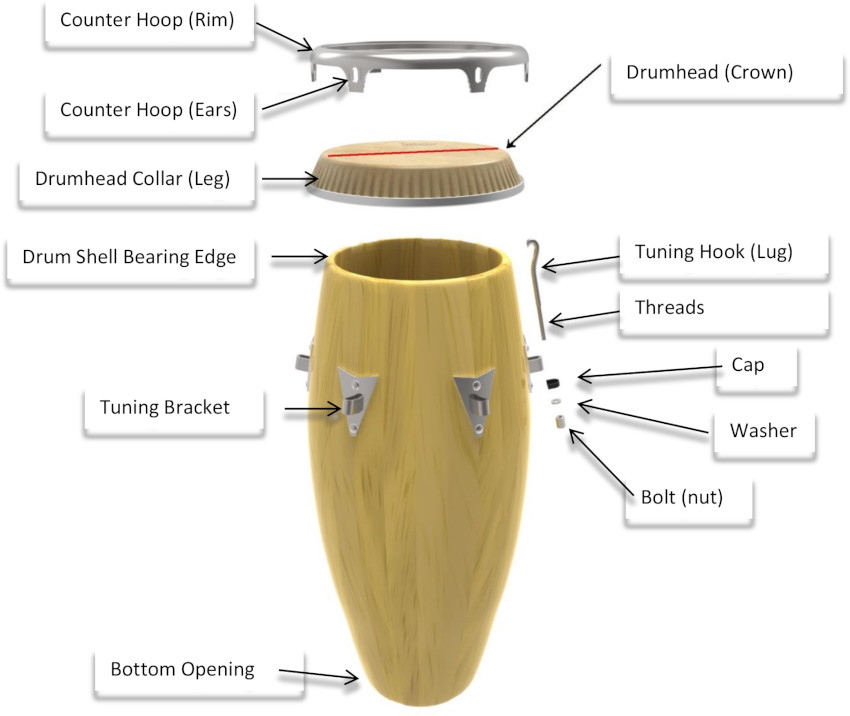
First, let’s take a brief look at the history of the conga drum. Originating in Cuba, conga drums were initially fashioned from old reclaimed oak wood wine barrels and featured tack heads. Over time, metal tensioners (lugs with metal side plates attached to a metal rim via hooks at top), were introduced to be able to tune the drum easily and to higher pitches.
This new metal tuning system also improved stability and sound. The drum heads were typically made from thick hides, predominantly from cows or mule skins. The body of the drum and its shape may have come from a combination of different sources.
The conga drum style is a rich fusion of African influences, primarily from the Yoruba and Congolese traditions, paired with Spanish influences and possibly even elements of flamenco. It’s important to note that there are many differing opinions on this topic, and I am not a scholar in this field. However, suffice it to say that the conga represents a hybrid style encompassing drumming, dance, and song traditions.
Rumba
Rumba is a form of music, dance, and rhythms. In folkloric rumba, there are three primary pieces: Yambu, which is a slower tempo focusing on themes and stories related to older generations; Guaguancó, a faster rhythm depicting the courtship of a rooster chasing after a hen. Both of these typically incorporate Spanish lyrics.
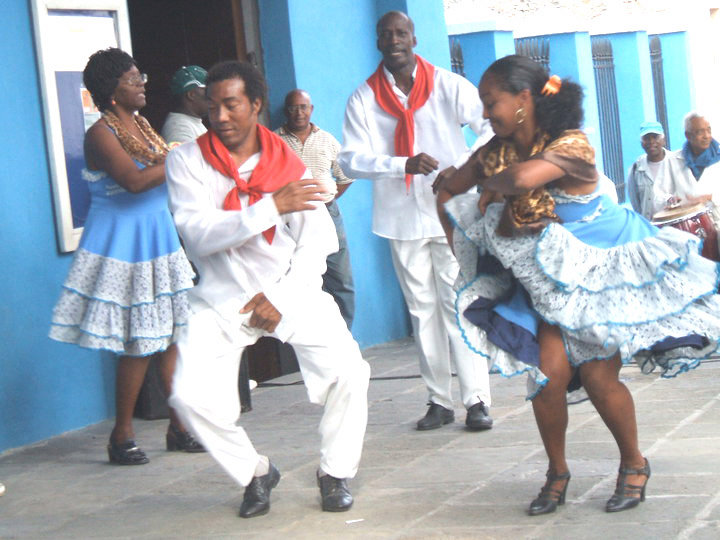
Guaguanco dancers have a special move called “vacunao” which when translated means to vaccinate. The male dancer tries to catch the female dancer and vaccinate her with a pelvic thrust. As politically incorrect as this sounds, that’s how it goes! The female dancer tries to block the vacunao. I have read that this move may have come from an African fertility dance.
Rumba Dancers in Cuba photo from David Peñalosa
Lastly, there is Rumba Columbia, a very brisk dance form that centers around men’s solo dancing and incorporates African lyrics—though the specific origins, be it Yoruba or otherwise, remain a subject of discussion. To me the Rumba Columbia dance looks like modern day hip hop or break dancing and also has the competitive vibe.
Cuba also boasts a multitude of other drumming styles, such as Arara, Gaga and Abakwa, to name just a few, each incorporating its own unique set of drums. In instances where these specialized drums are unavailable, their rhythms are often adapted for congas, which can be played with hands, sticks, or both.
The traditional rumba ensemble is always composed of three drummers. The tumbadora, the segundo, and the quinto, which is the lead soloist. One person on one drum each. There is always a clave player, (two short rounded sticks), someone cascara, also known as palitos, which is two sticks played on the cata instrument (which is made from the trunk of the tree and looks exactly like the Krin log drum from West Africa), and sometimes a shekere or shaker of some sort.
There is nothing in the rumba tradition that emphasizes the bass as there is in the West African traditional ensemble, which has the dununba, the lowest drum. In Cuba there are always dancers and singers accompanying the drummers, these three elements are never separate. The drummers also sing, along with the lead singer and backup singers.
The most important concept of Afro Cuban Rumba is the clave. The clave is not just an instrument it is a part. It originates out of what most people call the 6/8 bell. The clave is the “key”. It is also know as the center block in a wall that holds the whole wall together. Everyone listens intently to the clave, and the different claves that are in all forms of Afrco Cuban drumming and Afro Cuban music no matter if it is modern or classic.
Afro Cuban Rumba plays around the pulse and what drummers and musicians call “the one”, the downbeat. It circles it but does not emphasize it, it does not want to or need to. This is part of what makes rumba so special. It makes you want to dance but unlike rock and pop music, there is no pounding pulse. West African music will sometimes emphasize the pulse in pieces such as Djole and Makru for example.
You will find a low conga drum played at bembes, which are religious parties, where they might be accompanied by two or three shekeres if there are no bata drums.
Conga drums are also played at the yearly festival called Conga or Comparsa. These drums are usually lighter as they are worn while being played in the street.
West African Djembe Music
There is no official categorization of West African djembe music, but it’s generally agreed upon that there are three major styles: ballet style, which is based in the city and is a performance style; the traditional or ensemble style; and what I like to call the village style.

The ballet style was originally created by means of government sponsorship, to showcase the amazing talent of all the different regions of Guinea. It’s a conglomeration of many different styles of drumming, dance, songs, and instruments. The musical arrangements, dance choreography, and themes, tell stories in the oral tradition, entertain and enlighten, leaving spectators amazed.
Gymnastics moves were later added, rhythms were sped up to incredible speeds, and the drums were tuned higher so that it was easier to play faster and to execute rolls. The musicians from Guinea were inspired by the acrobatics of Chinese performance groups with which they came in contact by way of cultural exchanges in the ’60s.
The modern ensemble style was made popular by Famoudou Konate, Mamady Keita, and more recently by Bolokada Conde. It incorporates three dunun on every piece, and may use pieces from other West African countries, as well as pieces originally played on other instruments which they adapt to the three dunun drum ensemble format.
The dunun collectively consist of the kinkini, which is the highest of the three drums and plays a metronome type of part; the sangban, which plays the melody; and the dununba which plays the bass.
Village style might consist of some djembes with no dunun, or one or two of them. These drums might be older or of different styles than used in the performance groups. This style of drumming is for a specific community purpose, such as to celebrate a wedding, to accompany harvest, or to mark coming of age ceremonies.
Djembes traditionally are worn with straps and played while standing up. Of course they can also be played sitting down, which I personally prefer.
The Construction
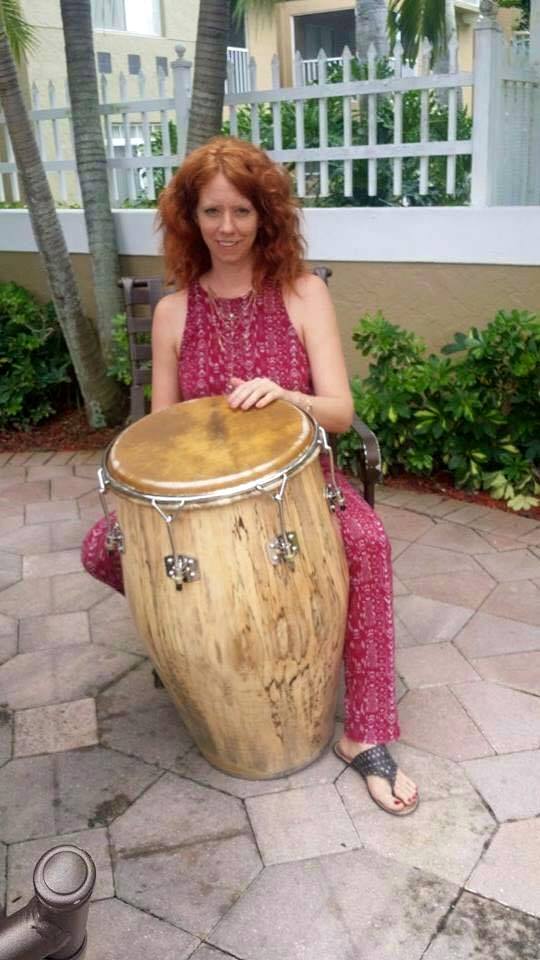
Congas are characterized by their tall, barrel-shaped design, and historically were crafted from repurposed wine barrels. They have a pronounced belly and tend to weigh several pounds more than djembes. Congas are traditionally played while seated, but can also be played standing, with the congas placed in metal stands.
While some congas are made from a single solid piece of wood, much like a djembe, they are more commonly constructed from staves that are bent by using steam, or by carefully cut wooden pieces that are glued into place. Sometimes they have metal bands, which long ago helped hold the staves in place. These days, due to huge improvements in glue quality and craftsmanship the bands don’t serve the same functional purpose and are used as decoration.
Manito Percussion solid shell one piece 15.5″ Mega Tumba built from a found log played here by south Florida percussionist Theresa Maneesha Rai
Manito is the only conga maker who actually turns complex shapes on the inside of his solid shell one-piece congas to create a better resonance chamber that boosts volume and sustain, bass response, and cuts overtones. In a commitment to sustainability, he only uses found local logs.
Companies like LP (Latin Percussion) also make congas from fiberglass. These drums are particularly effective in settings where greater volume is desired. LP is famous for its shorter, wider drums. Martin Cohen, the owner of LP, once told me this was a mistake, but people liked them, so he continued and the mistake became a hugely popular drum played by salseros to this day.
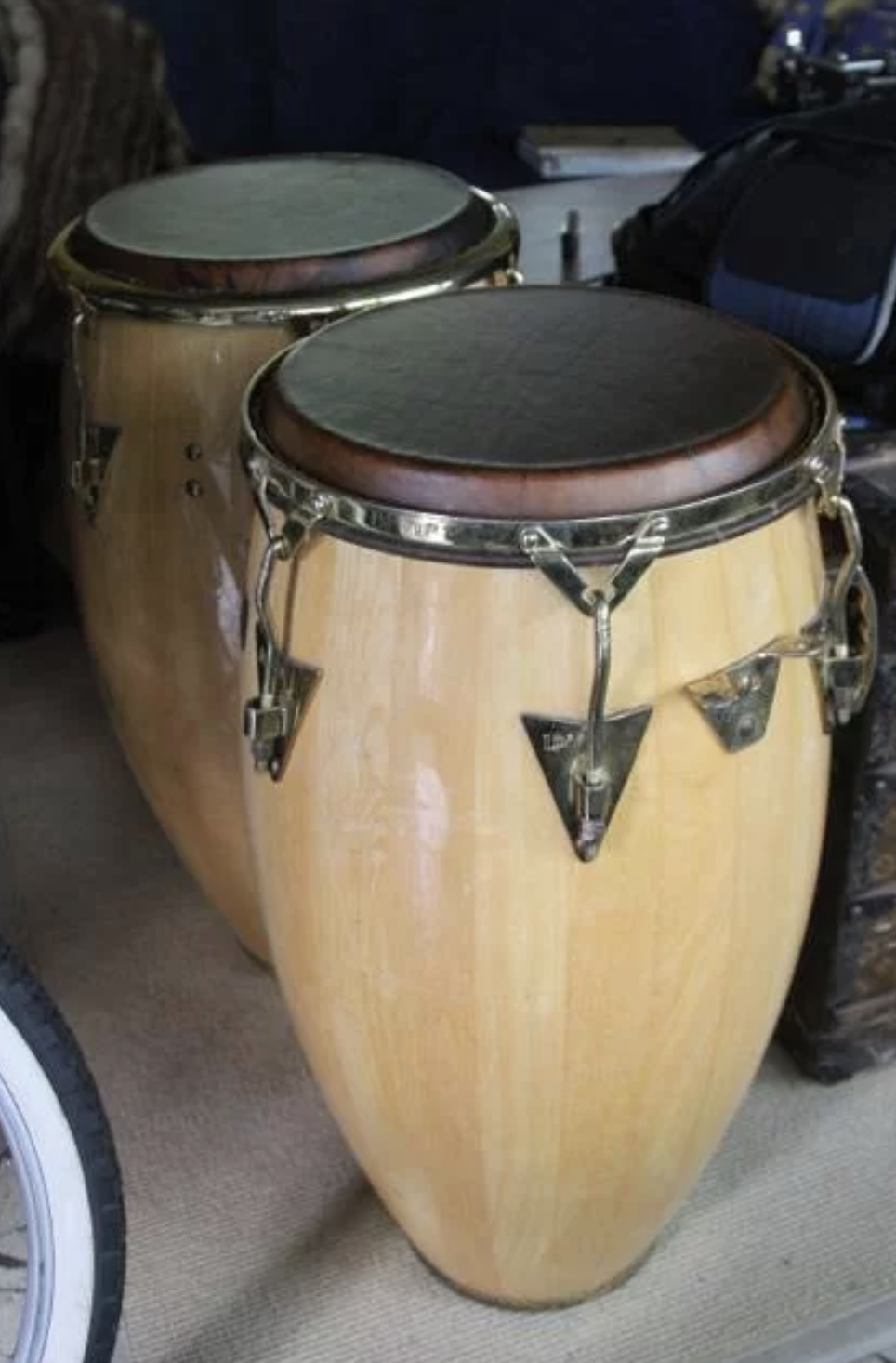
Most modern day conga drums are manufactured at such a high standard that if you simply change the head to a high quality skin like Manito, Pacific Coast Percussion by Stan Corpus, or others, your drum will sound much better then when it came from the Thailand factory with processed buffalo. The LP congas pictured here were re-headed and sound fantastic.
Djembes
Djembes were not influenced by hybridization nor by the effects of slavery in the same way as congas were. Although they arrived in the New World a little later than congas did, it wasn’t by much. Historical records suggest that congas made their way to the United States in the 1940s from Cuba, while djembes started to arrive in the late 1950s, thanks largely to the great master Ladgi Camara and later the legendary Olatunji, who included them in his New York-based group in the 1960s. I don’t have any data on how the djembe found its way to Europe and other parts of the world.
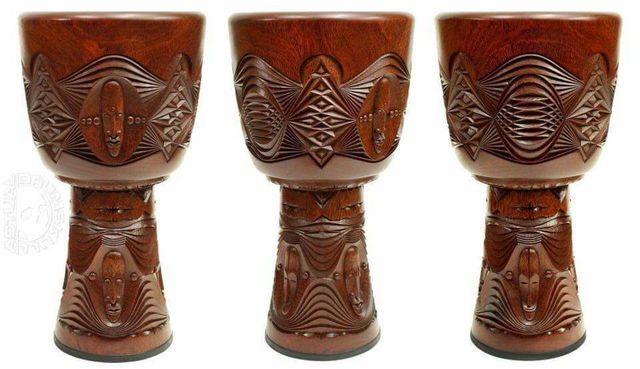
Today’s modern djembe has evolved significantly, often fitted with imported metal rings and strung with high-tensile imported rope. Until recently, djembes were carved from various hardwoods by hand. Eventually some brands were mass produced on lathes. Hand carved drums now feature decorative chip carving. This decorative addition allegedly occurred when European carving traditions were introduced to Guinea carvers by Tom Kondas of Koma Drum.
Mohamed Sylla from Guinea West Africa carved these fine drums for Koma Drums. Tom Kondas then heads them himself with goat skin

There’s some debate about who invented the djembe’s current tensioning system, specifically the method by which horizontal and vertical ropes form a diamond shape when pulled for tuning purposes. I have been told that it was a New Yorker named Chief Bey, (James Hawthorne Bey) who invented this system, but it may have been developed simultaneously in West Africa. I have spoken to people who were there when the system was first used in New York. There is a whole story on this subject here on my website if you would like to read more about it.
Many have tried to adapt conga drum hardware to djembes since the 1970s, but none have successfully replicated the distinctive sound produced by a rope-tuned djembe.
Djembes are generally shorter and lighter than conga drums and began to see popularity mainly through the rise of drum circles. Djembes are pitched higher than congas and feature thinner skins, making it easier for beginners to produce sounds, albeit often incorrectly. Hitting a djembe with intensity can yield sounds with minimal effort, whereas hitting a conga drum with similar intensity would likely feel uncomfortable due to its thicker skin and its metal hardware.
Djembe are crafted with thinner skins than conga drums, usually goat skin, though some players opt for calf, camel, mule, or buffalo hides, all of which are significantly thinner than conga skins. The calf skin and other skins can be very hard on your hands and also your bones. A lot of older players will not use the alternative skins whereas many younger players love them
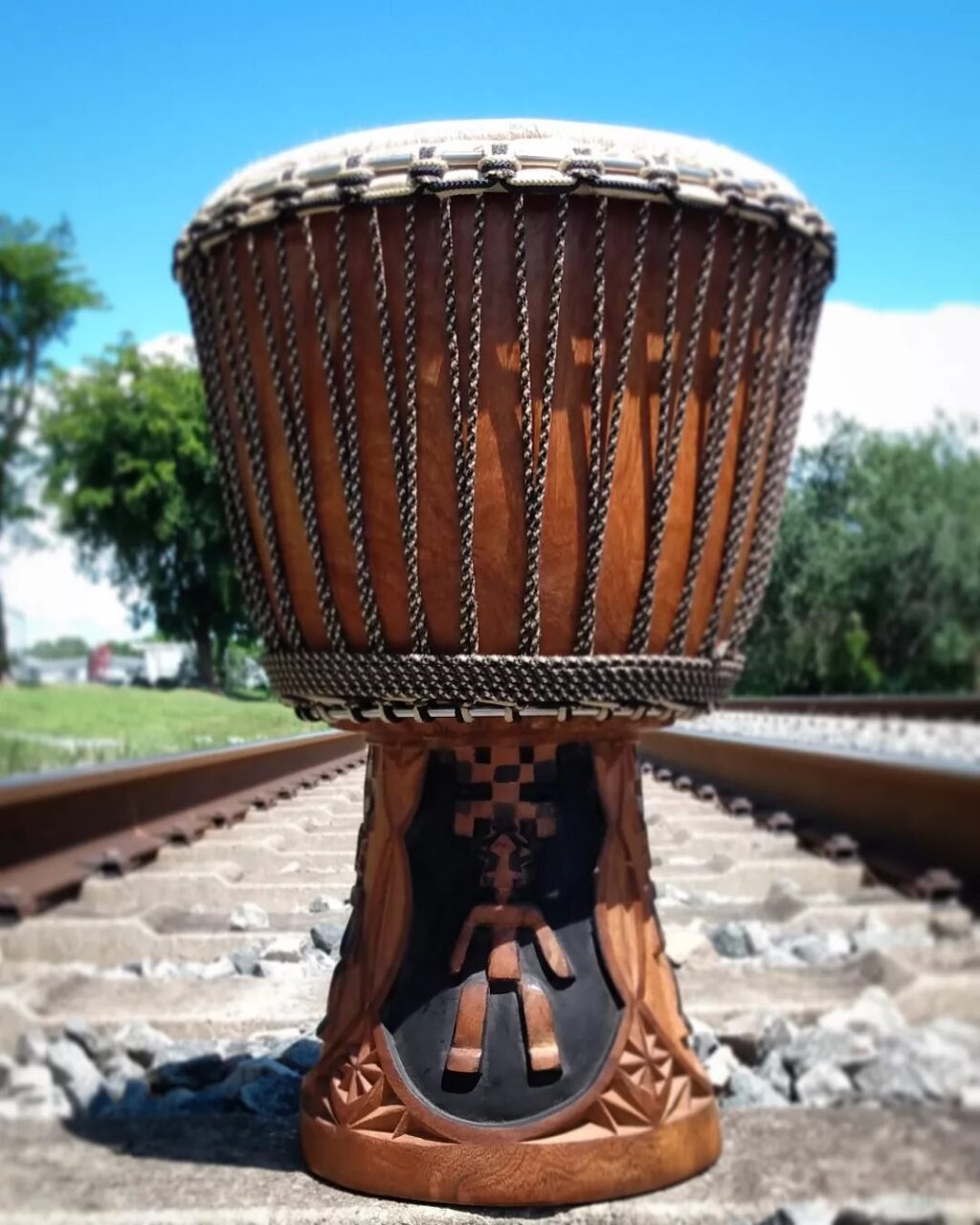
In the djembe world we have very talented people like David Joseph Hernandez of Djembe Life Drums and AJ Agostino of Lucid Drums, who not only repair drums but also acquire unfinished djembe shells from any number of sources and re work the shells so they will produce the best possible sound. This might involve rounding off the bearing edge of the rim, correcting unevenness in the shell body, or any number of repairs or improvements before heading the djembe themselves and adding embellishments to the outside.
David Joseph Hernandez of Djembe Life Drums specializes in getting the sound! He repairs and builds drums
These craftsmen often get better sound out of the drum than the original people who may have put the drum together on a strict timeline. They are also especially good at tuning drums. When a new head is put on a djembe, often it needs to be tuned a couple of times before it seats itself into a comfortable spot.
Playing Styles
The playing styles for djembe and conga drums differ considerably. Keep in mind that modern conga technique has evolved significantly over the last thirty years, as has djembe technique. The following discussion pertains to the current popular styles in contrast to the techniques I learned during my formative years in the late 1970s.
Both drums produce sounds categorized as slap, tone, bass, and touches, which are sometimes referred to as ghost notes. However, the striking area on a conga drum is larger than that of a djembe. You use more of your hand on a conga drum, while on a djembe you use less full hand and play more in the finger area.
Modern Cuban playing styles have seen the addition of very thick skins to the quinto. Just as in Guinea and Mali, the drums are being played tuned up to a very high level. Some of the modern rumba quintos sound like some of the Guinean djembe soloists who use calf skin on their drums.
Hand Positioning
The hand positioning on a djembe is different than on a conga. If you sit down at a djembe and put your hands on the head right at the edge of the rim, then point your two middle fingers together, your hand will form a triangle with the apex pointing to the center of the head. The hand position on a conga is still formed as a triangle, but with a less acute angle.
Energetically speaking
When you play a conga the energy is going down into the drum. The hands stay very close to the body and it’s all about the action in your wrists. Your arms are not supposed to go high in the air. Mongo Santamaria’s did, but that was a different generation.
While playing a djembe the energy is pulled upwards out of the djembe. It’s not as important to keep your arms close to the body and to the drum, unless you’re playing super fast, in which case that’s the only way you’ll be able to do it. Djembe playing emphasizes higher arm movement and a bounce technique, like you are bouncing a basketball off the drum’s head.
Slaps
On a djembe, slap tones are typically produced closer to the inner rim, with the fingers slightly separated, while on a conga, slaps and tones are struck more toward the center of the drum. Conga slaps can be open or closed, with open slaps allowing for more resonance.
A slap on a djembe is much brighter than a slap on a conga. The thin skin, the tightness of how it’s tuned, and the player’s technique all add up to make this happen. There is also a bit of sustain or ring on the djembe compared to a conga drum.
Tones
On a conga drum the tones are much fuller and rounder than those on a djembe. This could be due to the fact that more of the hand is on the skin, the thickness of the skin, and the tuning. On a djembe the tone is made in a similar way but with less of the hand involved.
Bass
The tumbadora, or tumba, the lowest of the conga drums, has a deep bass tone. The segundo or what we call the conga drum, is pitched a bit higher and has less bass. The quinto, which is the solo drum, can have almost none. Individual drums will have more bass than others. Djembes generally have a good bass tone because of the bowl shape of the drum, the diameter of the head, and the skin thickness.
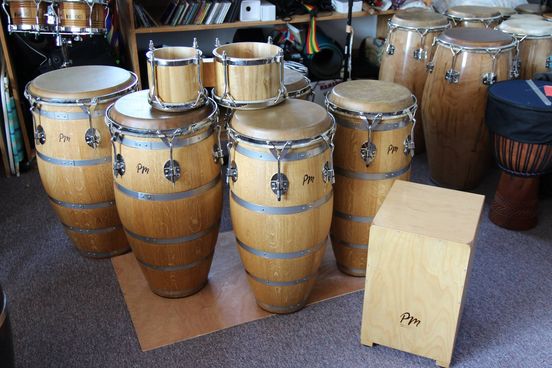
Peter Musser of PM Percussion of Petaluma, California made these conga drums out of imported oak wood that came from wine barrels, which he aged before building the drums. His attention to detail is second to none.
Technique
Modern conga playing has seen incredible developments with regards to technique and speed. Modern technique incorporates double-stroke rolls, Mano Secreta (the secret hand technique), and something called a shuffle, which is shuffling with a heel-tip rock on one or both hands; these techniques are less prevalent in djembe playing. I have an article on this website about this technique.
Djembe rhythms can maintain a hand-over-hand approach or a more constant, even-handed style, whereas folkloric conga drumming does not emphasize this method. Despite these differences, the underlying rhythms played on djembes and congas can share remarkable similarities, sometimes even being nearly identical.
Music
Both congas and djembes share roots in what is often referred to as the 6/8 bell pattern, resulting in numerous similarities when comparing traditional West African music to folkloric Cuban rumba. Congas can be played across a wide variety of musical genres, and a conga drummer might play one, or up to five drums. Melodies are shaped by various influences and can diverge significantly from traditional African drumming, making this comparison worthy of its own in-depth study.
Congas can be played in folkloric situations, but also with electric instruments in band situations, or in acoustic groups. There are many ways in which a conga can fit in. Because of the metal tuning system and thick skins, congas can be tuned quickly and easily for recording studio situations and almost always record better than djembes, or are much easier to record, at least in my personal and extensive recording experiences.
Multiple conga drums will produce different and clearly recognizable notes, which you can’t do with djembes. They have overtones so it’s much harder to pull out one individual note. The dunun collectively, which are part of the djembe traditional ensemble, are able to do that.
Djembes are played in popular West African pop music, in ceremonies and celebrations, to accompany work such as farming, for baby naming, and for many other contexts.
Rumba, especially Rumba Columbia can have a very fast tempo, I think some people call it duple meter. West African drumming, especially ballet style, can double and triple that speed. Blindingly fast.
Dununba parties and celebrations feature a competition for solo dancers, during which one person dances at a time in the modern style, much like Rumba Columbia where one dancer dances at a time. In Cuba it’s only men who dance Rumba Columbia, in Africa participation is for both men and women. Both Rumba Columbia and Dununba solo dance have striking similarities to modern day hip hop dance, especially in the competition aspect.
Rumba used to be made up of simple parts that held an easily recognizable melody, but in today’s style all of the parts move or speak.It’s a constant conversation and the only steady parts are the clave, cascara (palitos), shekere, and metal shaker.
Which is for you?
If you prefer melody and tonality, if you’re going to play in a band or in acoustic musical situations, smaller gatherings, and don’t mind carrying heavier drums, or you’re not going to be moving your drums around, congas are very nice. My personal experience gained through many years of recording on other people’s albums as well as my own, has shown me that congas always record much better then djembes and mix in much better with western instruments. You can have three congas drums of different sizes on which you can play traditional melodies, or make up your own on. This is something you can’t really do on djembes as the notes are not as clearly defined.
If you’re going to drum circles or jams and want a brighter sound, or you need a lighter drum that can be carried easily in a backpack case, then the djembe might be for you. You can also play congas in the aforementioned situations, it just does not work as well in my opinion. Ultimately it’s about personal preference.

